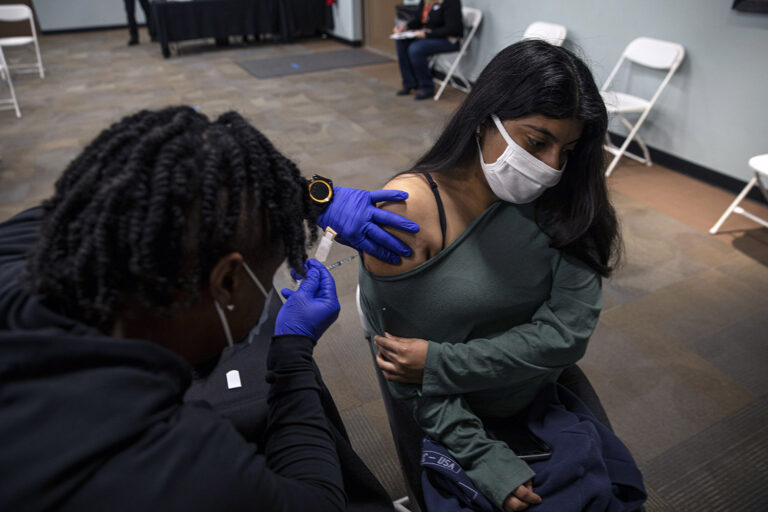By Emily Anthes and Noah Weiland, The New York Times
Goldman Sachs and Jeffries, the investment banks, are demanding that employees get booster shots. The University of Oregon and other institutions are requiring that students and staff members get boosters. New York state has said it plans to stop considering residents fully vaccinated unless they have gotten the shots.
As the highly transmissible omicron variant spreads from coast to coast, corporations, schools, governments and even sports leagues are reconsidering what it means to be “fully vaccinated.”
Now federal health officials, too, have taken on the question. Although top policymakers want to encourage Americans to get three doses, some would like to avoid changing the definition of a phrase that has become pivotal to daily life in much of the country, according to officials who spoke on condition of anonymity to describe internal deliberations.
Dr. Rochelle Walensky, director of the Centers for Disease Control and Prevention, said Tuesday that she and other health officials were “working through that question” now.
“There really isn’t debate here in what people should do,” she added. “CDC is crystal clear on what people should do: If they’re eligible for a boost, they should get boosted.”
With omicron’s sharp rise — more than 488,000 new cases were reported Wednesday alone — some experts think the moment for change has arrived. “I think the time is now,” said Dr. Georges Benjamin, executive director of the American Public Health Association. From a medical perspective, he said, receiving that additional booster dose “is really what we should be thinking of as fully vaccinated.”
Redefining “fully vaccinated” could lead to enormous logistical challenges, as even supporters of the idea concede, and it is likely to incite political backlash. Tens of millions of Americans who thought of themselves as vaccinated might discover that without boosters, they could lose access to restaurants, offices, concerts, events, gatherings — any place where proof of vaccination is required to enter.
Moreover, the change risks undermining trust in public health officials after two years of shifting recommendations, experts said. Some Americans may feel that the goal posts have been moved again, and too suddenly.
“While a determination of what constitutes full vaccination may be grounded in science, it does have significant political and economic ripple effects,” said Larry Levitt, executive vice president of KFF, a nonprofit organization that focuses on health issues.
The CDC currently defines “fully vaccinated” as those who have received two doses of the Pfizer-BioNTech or Moderna shots, or one dose of the Johnson & Johnson shot.
Although experts continue to believe that these regimens protect against hospitalization and death, the vaccines’ effectiveness against infection with the virus wanes over time. What had been considered full vaccination is substantially less effective against infection with omicron, which is able to partially evade the body’s antibodies.
A booster dose is likely to shore up the immune system’s defenses against the variant, reducing the odds of breakthrough infections, emerging research suggests — one reason boosters have become a pressing public health priority. Israel is now testing a fourth dose, or a second booster, in health care workers.
“The presence of a variant that is pretty smart at evading our vaccination has changed the game in a way that I just don’t think that the federal authorities have had time to process,” said Dr. Robert Wachter, chair of the department of medicine at the University of California, San Francisco.
“The guidance has to change when the science changes,” he added.
Although 62% of Americans qualify as fully vaccinated under the CDC’s current definition, just one-third of those people have also had a booster dose, including 58% of people 65 years and older, according to agency data. Only those who are 16 or older are eligible for boosters.
(Tracking the exact number of boosters can be tricky, and the CDC has warned that some boosters may be misclassified as first doses.)
Changing the definition of “fully vaccinated” could leave roughly 140 million Americans who are vaccinated but not boosted in limbo about where they stand and what they are eligible to do.
Many schools, businesses, governments and other institutions have relied on the CDC’s definition of “fully vaccinated” to establish mandates, requiring people to complete their primary vaccine series in order to attend school, dine out or remain employed.
But in the new omicron-dominated landscape, requiring just the initial vaccine series is no longer enough, Wachter argued.
“It’s just nonsensical to have that mandate coupled with a state of vaccination that we know is markedly less effective than you could achieve with a completely safe and easy-to-take additional intervention: one more shot,” he said.
Redefining “fully vaccinated,” and thus the mandates that rely on it, would be the most effective way to ensure that the public actually gets the booster shots that officials have been urging, he added.
The Biden administration has considered scrapping the term altogether and replacing it with language to the effect that vaccinations should be “up-to-date,” a phrase that may offer more flexibility as vaccine requirements change. (It is used to describe other vaccine regimens.)
The administration was leaning toward making such a move soon, according to two officials with knowledge of the discussions.
Defining what it means to be fully vaccinated depends on defining the public health goal for vaccinations generally, said Dr. Paul Offit, director of the Vaccine Education Center at Children’s Hospital of Philadelphia.
Boosters are likely to provide the best protection against infection with omicron. But for most healthy young people, the original two-shot series — or one dose of Johnson and Johnson — should be sufficient to prevent hospitalization and death, Offit said. If that’s the purpose of vaccination, then “these vaccines continue to hold up,” Offit said.
Dr. Philip Krause, a former top vaccine regulator at the Food and Drug Administration who retired last month, called efforts to redefine full vaccination a “distraction” from other public health priorities, adding that large vaccine efficacy studies and the CDC’s own data show two doses protecting strongly against severe COVID-19.
“The place where the risk is highest — among the elderly, the immunocompromised, people with comorbidities — those are the people accounting for almost all of the severe disease among the vaccinated,” he said. “We should be concentrating on finding those people” for booster shots, in addition to getting first doses to the unvaccinated, he added.
Changing the definition of “fully vaccinated” also is likely to intensify legal challenges to vaccination requirements, said Levitt, of KFF. The Biden administration’s attempt to mandate that large employers require employees to be vaccinated is already bogged down in the courts.
And requiring all workers to be boosted soon may be untenable in industries that are already struggling with labor shortages, he said.
“With so few Americans boostered at this point, it would be chaos in workplaces to all of a sudden require a third shot,” Levitt said, noting that for people who received the Pfizer-BioNTech or Moderna vaccines, boosters are not recommended until six months after the primary vaccine series. “It would take quite a bit of lead time to even implement a requirement for boosters.”
That has not stopped some companies and state officials from pressing ahead with booster requirements.
Goldman Sachs, which called most workers back to the office in June, will mandate booster shots for all eligible employees by Feb. 1. And Jefferies, the investment bank, told its staff that people returning to the New York office and attending the bank’s events will be required to have boosters by the end of January.
“This will not just be about Jefferies, as we anticipate that health authorities will soon consider only boosted individuals as ‘fully vaccinated,’ ” the company’s CEO, Rich Handler, and its president, Brian Friedman, wrote in a memo to staff.
The University of Oregon will require students, faculty and staff to get boosters by Jan. 31 or 30 days after they become eligible, joining a growing list of institutions with similar requirements. The University of Massachusetts issued a similar requirement Wednesday.
Omicron is surging in the Northeast, and Gov. Kathy Hochul, Democrat of New York, has said she plans to alter the definition of “fully vaccinated” to include having a booster shot. Gov. Ned Lamont, Democrat of Connecticut, said in November that residents should not consider themselves vaccinated unless they had had boosters.
But booster recommendations like those may need frequent revision as new variants appear and time passes, and it may not make sense for employers to require each new recommended shot, said Dr. Camille Kotton, an infectious disease physician at Massachusetts General Hospital and an adviser to the CDC.
And although changing the definition could encourage some Americans to get boosters, it could also harden opposition to vaccination among those who have not yet received any doses, experts acknowledged.
“People start questioning the science, questioning whether or not we really know what we’re doing — questioning, you know, am I gonna have to do this every six months?” said Benjamin, who supports changing the definition despite these challenges.
A redefinition would also lump together two very different groups: those who have received their primary shots and those who have received no doses at all, said Keri Althoff, a public health researcher at the Johns Hopkins Bloomberg School of Public Health.
Collapsing these groups into a new unvaccinated-partially-vaccinated category could make it more difficult for researchers to track important public health data or for officials to target their vaccine messaging, she said.
Ensuring that 38% of Americans who have not completed their primary vaccine series do so should remain the top priority, she said: “We cannot lose sight of that group.”
This article originally appeared in The New York Times.



















